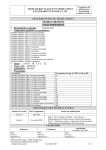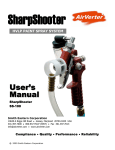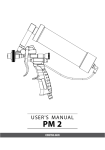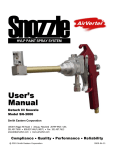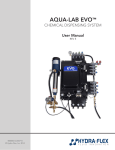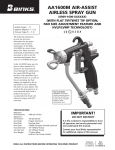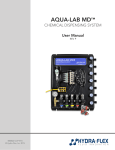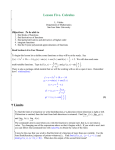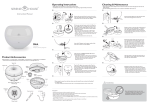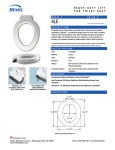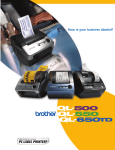Download PAINT DISPENSING SYSTEM USER MANUAL
Transcript
PAINT DISPENSING SYSTEM USER MANUAL Rev. 042004 Table of Contents Package Contents Nomenclature Principle Of Operation Tank Valves The Receptor EnviroCaddie™ Brand Paint Filling the Caddie Pressurizing the Caddie Mixing Procedure Applying Paint The Purging Process Replacing the Vertical Action Valve Troubleshooting Page 1 1 2 4 5 6 7 8 8 9 10 11 PACKAGE CONTENTS EnviroCaddie Paint Dispenser Box • EnviroCaddie™ Paint Delivery System • 6’ Charging Hose Assembly • Mixer Drive Assembly • Trigger Handle Assembly • User Manual • Instructional CD Rom Startup Kit • Argon Regulator Assembly • 6’ Charging Hose • Paint Funnel (1 per color ordered) • Paint Pouring Spout (1 per color ordered) • Spare Parts Kit Page 2 NOMENCLATURE ITEM PART NO. DESCRIPTION 1 167-200 Receptor Body Assembly 2 167-201 Retaining Ring 3 See Chart Actuator 4 167-202 Vertical Action Valve 5 133-105 Vertical Valve Lower Seal 6 167-208 Handle Retainer 7 167-209 Thumbscrew 8 n/a Needle Valve Note: No other serviceable parts are on the receptor assembly. Factory service only recommended Figure 1 Page 3 NOMENCLATURE (cont.) Paint Tank Figure 2 ITEM 1 2 3 4 5 6 7 8 9 10 11 PART NO. 267-110 267-125 267-102 267-103 n/a 267-104 267-107 267-106 267-105 267-101 233-115 DESCRIPTION Bulkhead Connectors Mixer Drive Assembly Pressure Gauge Charging Valve Receptor Holder Pressure Relief Valve Propellant (Argon) Valve Product (Paint) Valve Argon Flow Controller Fill Cap Depressurization Valve Page 4 PRINCIPLE OF OPERATION Tank Valves Figure 2 shows the two shut-off valves mounted on the tank top. The propellant valve (Item #7) is used to supply Argon to the receptor. When this valve is opened, the pressurized Argon passes through the flow controller (Item #9) and to the first ⅛” OD Teflon® supply line feeding the receptor. A metered amount of Argon is used for both, atomizing the paint, and purging (cleaning) the receptor. This process will be detailed in the next section. The product valve (Item #8) is used to supply paint to the receptor. Opening this valve delivers paint to the second ⅛” OD Teflon® supply line that feeds the receptor. During normal painting operation, both valves (Items #7 & #8) should be in the fully open position. The Receptor The receptor (Figure #1) was designed to be compact, versatile, and trouble-free. A single valve is utilized to simplify operation. In the closed position, only Argon is dispensed when the actuator (Item #3) is pressed. This is the “Purge” position of the unit. When the needle valve (Item #8) is opened, product is allowed to pass into the vertical action valve (Item #4) and through the actuator’s nozzle, producing the spray pattern. The EnviroCaddie System is designed specifically for use with our proprietary paint formula. Page 5 ENVIROCADDIE™ BRAND PAINT The Sheboygan Paint Co, of Sheboygan, WI, provides our touchup paint that is formulated, specifically for the EnviroCaddie. SPC is a mid-size, national paint company that specializes in “nichemarket” coatings for both OEM and industrial/maintenance applications. Our EnviroCaddie touch-up paint is a modified, super fast air-dry acrylic that provides superior adhesion, exterior durability, rust protection, and high gloss retention. When sprayed by the EnviroCaddie, paint performance and productivity is greatly increased while cost, compared to the aerosol can, is dramatically reduced. Paint Preparation: Like all paint applications, it is important to clean the area to be painted so that it is free from all dirt, oil, grease, and loose (rust) material. It should also be dry to achieve good adhesion. Filling the EnviroCaddie: When filling the EnviroCaddie for the first time, or when empty, it is important to open the gallon paint can and stir the paint thoroughly with the provided paint stick so that the pigment is fully suspended and not left on the bottom of the can. This is very important as the pigment provides good hiding and in most cases one-coat coverage. Do not open the Caddie until this is done. VERY IMPORTANT: EnviroCaddie paint is a very fast, air-dry enamel coating and it is, therefore, important that a lid be kept on the gallon pail until it is ready to pour. A re-usable plastic lid with a pour spout is provided with each Caddie for this purpose. Page 6 FILLING THE CADDIE If the Caddie is being used for the first time, there is no pressure inside, the fill cap (Fig. 2, Item #10) can be removed by turning it counterclockwise until free. IMPORTANT!! If the Caddie has been in use and is under pressure, open the depressurization valve (Fig. 2, Item #11) before attempting to remove the fill cap!! DO NOT TRY TO REMOVE THE COVER IF THE UNIT IS UNDER PRESSURE • Unscrew the fill cap to open the top of the tank. A removable filter made of 100-mesh Stainless Steel rests on a rim inside the opening to prevent particles from entering the Caddie that could potentially clog the orifices. • Remove the paint container cover and stir with the provided stick until thoroughly mixed. • Snap the pouring spout on the paint can and pour contents into tank. • Replace the fill cap by turning it clockwise until the seal makes contact with the tank spout and tighten another ⅛ turn. • The Caddie is now ready to be pressurized. Page 7 PRESSURIZING THE CADDIE The Caddie is easily pressurized with the enclosed charging hose. Charging pressure is to be set at the regulator to 125 psig. Charging the Caddie to higher pressures will result in unsatisfactory spray pattern and finish. IMPORTANT!! DO NOT use compressed air to charge the Caddie!!! This will result in a vapor mixture inside the tank that will be highly flammable and Oxygen rich. NFPA guidelines prohibit the use of compressed air in vessels with this volume capacity. USE ONLY Argon for pressurization. Figure 3a • • • • • • • Figure 3b Close both valves on the top of tank (Figure 2, Items #7 and #8) Remove cover from charging valve as described above in the previous section Attach charging hose by pressing down to engage lock (Fig. 3a) Wait until pressure gauge indicator reaches the “Full” hash mark Release charging hose lock by pulling down on the snap (Fig. 3b) Remove charging hose and replace the dust cover The Caddie is now full and charged. Page 8 MIXING PROCEDURE When a fresh batch of paint is first poured into the Caddie, it is presumed to be thoroughly mixed and ready for use. If the Caddie contains paint and has been unused for at least 4 hours*, re-mixing is necessary. Tools supplied with the Caddie to accomplish this procedure are a 5/8” Swivel 3/8” Drive Drill Adaptor. • Attach the 5/8” Swivel Adaptor to the drill. • Place the 5/8” Socket on the Mixer Drive (Fig. 2, Item #2) • Turn mixer drive at approximately 300-500 RPM (clockwise) for about 3 minutes • Paint is now mixed and ready for use. APPLYING THE PAINT The EnviroCaddie was designed to be as easy to use as the aerosol spray can, but with many added features. Spraying is as simple as pointing the receptor and pressing the actuator. For most paints, a spray distance of 6-8” is suitable, although experience and familiarity with the unit will result in the user developing various techniques for the different formulas. Advantages of the innovative receptor design include: • Paint with the receptor in any orientation, even upside down • Easily replace the vertical action valve (Fig.1, Item #4) if it ever becomes clogged • Locking trigger handle eliminates radial movement that can block the spray pattern • Provides Argon atomization of paint allowing for more even surface coverage • Easily purged for storage by simply closing the paint valve and spraying Argon through actuator Page 9 THE PURGING PROCESS Purging the receptor is a very important part of normal day-to-day operation. Purging cleans the paint from the upper chambers prior to storage. This is similar to turning an aerosol can upside down and pressing the actuator. Purging is achieved by closing the paint needle valve and pressing the actuator for 5 seconds. Figure 4 below shows the result of a proper purge. Figure 4 Page 10 Replacing the Vertical Action Valve Refer to figure #1(Receptor) except when otherwise noted. IMPORTANT ! ! Follow these procedures carefully to avoid personal injury or damage to the equipment !! Removing The Vertical Action Valve • • • • • • Close needle valve at the receptor (Item #8) Depress the actuator (Item #3)to purge the unit Close valves at tank (Items 7 & 8 Figure #2) Depress the actuator again to release remaining pressure Remove thumbscrew (Item #7) and handle retainer (Item #6) Remove handle by turning clockwise ½ turn and pulling down on handle • Unscrew retaining ring (Item #2) • Carefully pry up vertical action valve (Item #4) while being careful not to lose the lower seal (Item #5) • Inspect the lower seal for damage, if good it can be re-used Page 11 Replacing The Vertical Action Valve • • • • • • • • • Place lower seal (Item #5) in receptor bore Place the new vertical action valve (Item #4) on receptor Replace and tighten retaining ring (Item #2) Install new actuator (Item #3) Replace the handle by placing the front into the receptor, pressing the rear back and turning ½ turn clockwise. Replace the handle retainer (Item #6) and the thumbscrew (Item #7) Open valves at tank (Items 7 & 8 Figure #2) Depress actuator (Item #3) to check purge function Caddie is now ready to dispense paint Page 12 TROUBLESHOOTING Problem Possible Cause Tank Valves Closed Needle Valve Closed Caddie Will Not Spray Low Argon Pressure Actuator is clogged Low Argon Pressure Spray Pattern Is Poor Actuator is clogged Spray is too close to work Temperature below 55°F Paint Heavy Or Runs Caddie temperature below 55°F Paint is not mixed thoroughly Low Argon Pressure Argon valve not fully open Paint Spray Sputters Faulty vertical action valve Partially clogged actuator 1 Solution Open tank valves Open needle valves Pressurize tank Replace actuator Pressurize tank Replace the actuator Spray 6-8” from work take work to warmer area if possible Store Caddie in warm area Mix paint as per procedure on page 8 Pressurize tank Open Argon valve on tank Replace Valve Replace actuator To check for clogged actuator: • Close all valves • Open the tank Argon valve (Figure 2, Item #7) • Depress the actuator (Figure 1, Item #3) • Argon should be heard exiting lightly out of the actuator Page 13 EnviroCaddie, LLC PO Box 803 Bridgewater, MA 02324 Customer Service and Technical Support 888-867-1800 or fill out a support form at: http://www.envirocaddie.com Engineering and Compliance: Ray Valdes [email protected] Sales Support: Pete Fairlamb [email protected] Rev. 200906 Page 14















